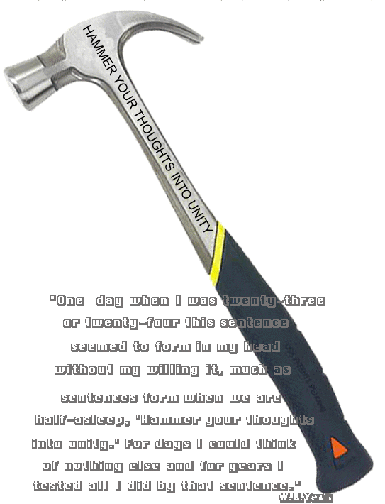
‘One
day when I was twenty-three or twenty-four this sentence seemed to
form in my head, without my willing it, much as sentences form when we are
half-asleep, ‘Hammer your thoughts into unity’. For days I could think of
nothing else and for years I tested all I did by that sentence [...]” William
Butler Yeats (cited in Frank Tuohy, Yeats <, 1976, p.51 )
Learning Record Instructions
A.1.
Take the psychological “type” test of the Meyers-Briggs variety, such as that at http://www.humanmetrics.com/cgi-win/JTypes1.htm
Print out the results and include them in your document. Then check out the descriptions of the related learning styles in our course anthology and add a evaluation of at least 300 words of how well you believe "your" learning and writing styles describe you as a reader and writer.
A.2.
500 words or more of your reflections on your own development as a reader and writer, especially in relation to your thoughts and feelings about the goals and themes of the course.
Goals list.
Make a numbered list of your own personal goals in the course, explaining your choices as you go along. 300 words or more. Make sure the list of goals focuses on your education in this course, not, say, getting a job for the summer, relating better to my boy/girlfriend, roommate, etc. Attach a copy of this numbered list to every subsequent LR assignment, including the Midterm and the Final.
Observation.
In general, when a Learning Record Observation is due you will hand in two or more pages typed, double-spaced, on your development since your last LR assignment in confidence, independence, and skill with respect to reading, writing, speaking and listening, and the specific course goals you adopted. You will include an “updated’ list of goals and organize your observation by number corresponding to your goals. You will notice the word “updated” concerning goals because you may revise them as you go along. If you do, make sure to show how you revised them on the first page and explain in the observation why you did so.
However, now you will especially want to be reflective, increasing your consciousness of your own learning styles and creative processes. A key to this awareness is to incorporate quotes from Ram Dass's The Witness, in your course anthology: points will be awarded for these quotations. Particularly important is your development in relation to the course strands indicated by the assignments we have covered in the previous time period in the course. For example, in the first weeks those strands might be interpersonal skills (getting to know classmates); computers and HTML; left vs. right side of the brain, visual as well as verbal ways of knowing; interdisciplinary connections (between writing, drawing, reading, architecture, landscape architecture, etc.); emotional literacy and other intelligences; relations you perceive between this class and past courses (“hammer your thoughts into unity”); discovery learning, . . . .
Include pictures of yourself and/or the class in action, but this is not a diary, not a record of what you did. You need to be self-reflective: focusing on how well you are meeting your goals for the course, changes in your awareness of self and the world around you, development of new styles of learning, etc.
Your LR also includes complaints, difficulties with the course, and suggestions for changes.
LR Midterm.
This is an Observation (see above) of at least a thousand words of your awareness of your own learning styles and creative processes. Title this essay, “Stand outside yourself and write what you see.” Remember to incorporate quotes from Ram Dass's The Witness, in your course anthology: points will be awarded for these quotations.
Make this also a midterm summary of your progress toward the goals on the updated list you will include with the midterm document. This summary includes
[1] your guess as to what grade you would receive if the course ended at this point, using the online gradebook and the grading system outlined in the course description;
[2] suggestions for your own further development during the remainder of the semester;
[3] suggestions for class activities or for the professor to better support learning;
[4] pictures of yourself in action in the course.
LR Final.
Title an essay of at least two thousand words, “stand outside the person standing outside yourself and write what you see.” Remember to incorporate quotes from Ram Dass's The Witness, in your course anthology: points will be awarded for these quotations.
In the process judge how well you have met the goals you set out in previous LR documents (include your updated list of goals in this LR Final), not only in terms of what grade you seek, but what skills, ways of knowing and being, etc. you wanted to develop.
In the process, integrate your road map (if assigned), any drawings, if relevant, and all your previous LR documents, and summarize. Do not just reproduce your previous LRs word for word. “Hammer your thoughts into unity.”
As you do so, evaluate the course in terms of what worked for you and what did not.
Because visual rhetoric is a large component of the grade for the LR Final you should include not only pictures of yourself in action in the course, but also class pictures, a feature that might well help you get a good grade on this part of the portfolio, if the other requirements are met.
Add estimated evaluation in terms of grade (see course description and online gradebook for how to calculate your grade).
Make suggestions for class activities or for the professor to better support learning and meeting goals like yours in future versions of the course.
Turn in the LR final to Par 132 during the specified time or before, keeping a copy for your portfolio.
